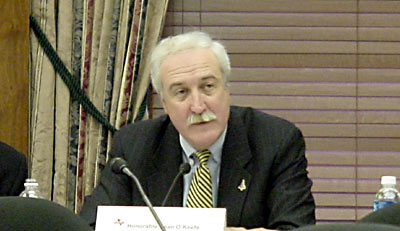Public space travel and a national space visionAn open letter to NASA Administrator Sean O’Keefeby Derek Webber
|
| I urge you to think seriously about public space travel, the very essence of the American Way—taking some risks, pushing back frontiers, making money and having fun; the ultimate expression of freedom, in fact. |
I am not one to offer a destination- and schedule-driven vision goal. You have enough advocates of them already, both inside and outside your organization. Nor can I offer a total vision; that is in any case your job. However, I am firmly convinced of part of the content of the New Space Vision. I promise you that it will cost very little (or even zero if you manage it via a reallocation of resources), it will energize the youth and reengage the American public (I have the data to prove it), and it will furthermore bring about a reversal in the gradual decline of the US space program in its global competitive context. So what is the downside? It involves thinking outside the box, and a conscious departure from all of NASA history, and culture, to date. It will meet with resistance from parts of your workforce.
I urge you to think seriously about public space travel, the very essence of the American Way—taking some risks, pushing back frontiers, making money and having fun; the ultimate expression of freedom, in fact. You said Tuesday that the commercial space markets do not look good right now. I do not disagree. But you had the foresight to fund the $1.8-million ASCENT (Analysis of Space Concepts Enabled by New Transportation) study to look into just this question about markets in the context of the Shuttle replacement work. The answer came back, and public space travel was clearly identified as a real growth market. In fact it was the growth market. So far, though, it seems your organization does not want to accept, and benefit from, the study findings. Last year’s Aerospace Commission report embraced the conclusions and made them part of its space recommendation. The FAA has now understood this, and moved rapidly to put in place a workable licensing regime. Burt Rutan and other X Prize contenders will soon initiate the suborbital space tourism sector. However, the real goal is orbital tourism. This is where NASA can help, in line with its charter obligation to space commerce, and so ensure that this new industry does not go by default to the Russians and the Chinese. Incidentally, even the Europeans are now building a Soyuz pad in French Guiana that will make orbital tourism possible within a few years for their public space travelers.
| I also predict that increased public interest would translate into increased public funding. Why? Because the American public wants to go! |
I therefore suggest that you embrace this development, include it as part of the New Space Vision, and take two very simple initial steps to make it happen. First, create a small Office of Public Space Travel (budget around $5 million a year) with responsibility to ensure that NASA facilitates these developments (e.g., makes training facilities available for the new public space travelers.) Second, direct that the new office has input to ensure that the design of the Orbital Space Plane, or its successor, will take into account its possible subsequent use for orbital public space travel.
These two simple steps would, I submit, bring about a very great benefit for little or no cost. This would be a trigger for financing of spaceport development plans with associated employment implications in the states, and would send a signal that the US was taking steps to reverse its decline in world space markets. Inside NASA, there would be new future roles for the astronaut office to create for itself in the longer term. I also predict that increased public interest would translate into increased public funding. Why? Because the American public wants to go!
